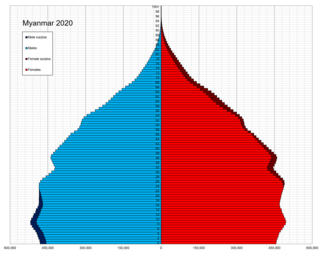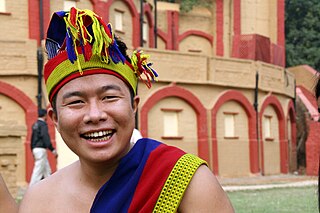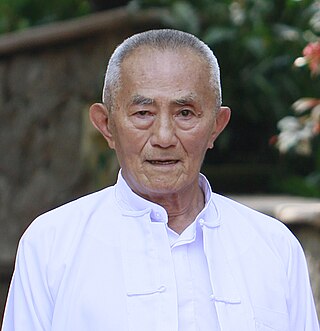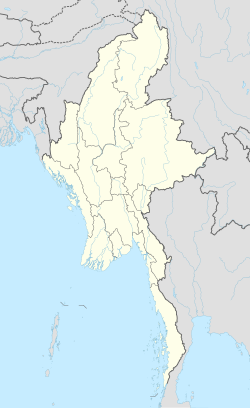
This is a demography of Myanmar including statistics such as population, ethnicity, language, education level and religious affiliations.

Arunachal Pradesh is a state in Northeastern India. It was formed from the erstwhile North-East Frontier Agency (NEFA) region, and became a state on 20 February 1987. Itanagar is the state capital.

Nagaland is a landlocked state in the north-eastern region of India. It is bordered by the Indian states of Arunachal Pradesh to the north, Assam to the west, Manipur to the south, and the Sagaing Region of Myanmar (Burma) to the east. Its capital city is Kohima and its largest city is the twin Chümoukedima–Dimapur. The state has an area of 16,579 square kilometres (6,401 sq mi) with a population of 1,980,602 as per the 2011 Census of India, making it one of the smallest states of India.

Myanmar is divided into twenty-one administrative subdivisions, which include 7 regions, 7 states, 1 union territory, 1 self-administered division, and 5 self-administered zones. Following is the table of government subdivisions and its organizational structure based on different regions, states, the union territory, the self-administered division, and the self-administered zones:

The Naga people are various ethnic groups native to northeastern India and northwestern Myanmar. The groups have similar cultures and traditions, and form the majority of population in the Indian state of Nagaland and Naga Self-Administered Zone of Myanmar (Burma); with significant populations in Manipur, Arunachal Pradesh and Assam in India; Sagaing Region and Kachin State in Myanmar. The Nagas are closed related to the neighboring Chin and Kachin people of Myanmar and northeastern India.

Dimapur is the largest city and municipality in the Indian state of Nagaland. As of 2011, the municipality had a population of 122,834. The city is the main gateway and commercial centre of Nagaland. Located near the border with Assam along the banks of the Dhansiri River. Its main railway station is the second busiest station in Northeast India.

Pakokku is the largest city in the Magway Region of Myanmar. It is situated about 30 km north-east of Bagan on the Irrawaddy River. It is the administration seat of Pakokku Township, Pakokku District and Gangaw District. Pakokku Bridge is part of the India–Myanmar–Thailand Trilateral Highway and is the longest bridge in Myanmar. It is home of the Pakokku Airport.

Mon District (Pron:) is a district of Nagaland, a state in India. It is the third-largest district in Nagaland in terms of area. The district has a population of 250,260 people. Mon Town is the headquarters of the district.
Leshi, is a town in Naga Hills of Sagaing Division on the north-west frontier of Burma. According to the new 2008 Constitution of the military regime, it will now be grouped together with Lahe and Nanyun in Naga Self-Administered Zone. Leshi is reached via Htamanthi across the Chindwin River by boat from Homalin, and there are domestic flights from Yangon and Mandalay to Homalin.

The National Socialist Council of Nagaland (NSCN) is a Naga nationalist and separatist group operating mainly in Northeast India, with minor activities in northwest Myanmar (Burma). The main aim of the organisation is to establish a sovereign Naga state, "Nagalim", which would consist of all the areas belonging to the Naga people in Northeast India and northwest Myanmar.
The Lothas, also known as Kyongs are a major Naga ethnic group native to Wokha District in the Northeast Indian state of Nagaland.

The Naga Self-Administered Zone, is a self-administered zone in the Naga Hills area of Sagaing Region of Myanmar. Its administrative seat is the town of Lahe.
The Khiamniungan people, also known as the Khiamniungan Naga, are a Tibeto-Burmese ethnic group, with approximately 35% of the population inhabiting in Noklak District in the Northeast Indian state of Nagaland and the rest in Naga Self Administered Zone and Hkhamti district of Myanmar. They were also called Kalyo-Kengnyu during the British Raj.

The Yimkhiung people, also known as the Yimkhiung Naga, are a Tibeto-Burman Naga ethnic group inhabiting the territories of Shamator and Kiphire District in the Northeast Indian state of Nagaland and western areas of Myanmar.
Ningthi is a village located west of Kamjong in Kamjong district, Manipur state, India. The village is about 20 kilometers from Kamjong and is partially connected by Ukhrul-Kamjong State highway and inter village road constructed in 2015. Ningthi is flanked by Kamjong in the east, Phungyar in the west, Tusom in the south and Hangkau in the north. Ningthi river is the main tributary of Chindwin river of Myanmar.
Kangpat is a generic reference to two villages, Kangpat Khullen and Kangpat Khunou located south of Ukhrul in Ukhrul district, Manipur state, India. The village falls under Kamjong sub division. The two villages are connected by Ukhrul-Kamjong state highway. Kangpat is flanked by Sorbung and Punge in the west, Choro in the south, Skipe in the east and Nambisha in the north. Locally, the inhabitants speak Kangpat dialect that belongs to the Tibeto-Burman language family. Some researchers are of the view that the dialect spoken by the inhabitants has some affinity to that of the Koireng tribe.
Skipe is a border village on the side of India in the Indo-Myanmar international border. The village is located south of Ukhrul in Ukhrul district, Manipur state, India. Skipe falls under Kamjong sub division. The village is partially connected by Ukhrul-Kamjong state highway. Skipe is flanked by Chindwin river in the east, Konkan Thana in the north, Kangpat in the west and Namlee in the south. Locally, the inhabitants speak Skipe dialect that belongs to the Tibeto-Burman language family. Some researchers are of the view that the dialect spoken by the inhabitants has some affinity to that of the Koireng tribe.

The Anāl are some of the oldest settlers of the present day Manipur. They belong to the Naga tribe native to Manipur state in North-East India and part of Myanmar. The name "Anal" was given by the Meitei people of Manipur valley. They are listed as a Scheduled Tribe, in accordance with The Scheduled Castes and Scheduled Tribes Orders (Amendment) Act, 1976 Indian Constitution. The Anāl tribe is one of the 'sixty six Naga tribes' of the Naga ancestral homeland. The members of this tribe are found both in India and Myanmar. In India, they are situated in the States of Manipur and Nagaland but mostly concentrated in the former. In the State of Manipur, the Anāl Naga population concentrated in Chandel and a few Anāl villages are located in its neighbouring districts, Churachandpur district has about three villages and Thoubal district has one or two.

Thein Hlaing, known honorifically as Naga Thein Hlaing, was a Burmese surgeon. He was well known for his performance of endocrine surgery in the Naga Hills of northwestern Burma, using local anesthetic only. Since he was able to cure goitre, which local shamans could not do, Thein Hlaing was recognized by the local residents as Naga Nat and was worshiped as a deity.















